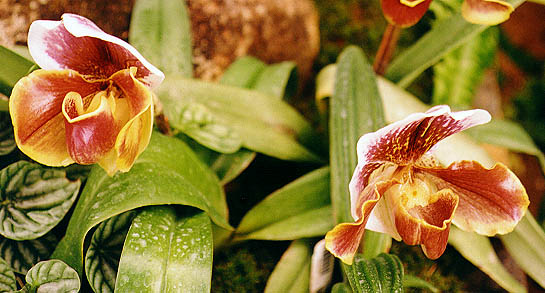| Flower colors |
The wide petals are yellow and red-brown
mottled. The sepals yellow-whitish and red-brown mottled. The lip is
yellow strongly veined with red-brown letting a beautiful yellow margin.
|
| Number of flower for spike |
Almost all species are solitary-flowered
specially those which need cool conditions. However there are some
multiflora species like Paphiopedilum lowii. |
| Flower size |
As the picture was taken during an orchid
show and we couldn't measure it. In fact it was a big flower. |
| Preferred conditions |
They need intermediate to cool conditions.
They do not like strong light which can scorch their leaves. Although they
need medium to low light levels under natural conditions (dense tropical
forests), in cultivation, they have to be given a little more luminosity.
To find the correct average lighting, pay attention to the leaves: if they
turn dark, they are receiving less than they need, if they turn to yellow
or pale green, the light is too strong. In summer, it needs plenty of
shade. Feed with a high nitrogen fertilizer in a half dose during the
growth period and none during the winter. The compost should be constantly
moist as there is no pseudobulb to stored water. Be sure there is no
standing water in the leaf axils. Good ventilation is important to avoid
any rotting. Small pots, deeper than wider with substrate to terrestrial
genus It is not a very easy plant to cultivate but the hybrids are, in
general, easier because are more adaptable and less dependent of defined
temperature patterns. |
| Season of bloom |
Winter (once a year). |
| Origin |
This a complex hybrid formed by mainly an unknown species, then
Paphiopedilum spicerianum (northeast India and northwest
Burma), insigne (Nepal and northeast
India), boxallii, exul (Thailand), villosum (India,
Burma and Thailand), hirsutissimum (India and China) and
bellatulum (Burma and Thailand).
|
| Comments |
Most species has a single flower per
inflorescence. Some groups are multiflora bearing a few flowers
concurrently. Some others are also multiflora but the flowers are produced
one after other in a slow succession. |

